As a Gen X RVer, I’ve rolled through a few decades of road trips, from the days of neon windbreakers to streaming on tablets. And if there’s one thing I’ve learned, it’s that winter camping can humble even the most seasoned traveler.
We all think we know how to handle some chilly weather. After all, we grew up scraping ice off windshields and trudging through the snow to get to school—back when “staying home” wasn’t an option unless you were really sick. But RV life in the snow? That’s next-level.
If you’re not careful, you might end up dealing with frozen pipes, dead batteries, or other mishaps that can turn your winter wonderland into a headache.
Still, don’t let that scare you. The key to a smooth winter RV trip is knowing the common pitfalls—and how to avoid them. That’s why I’m sharing the top 17 mistakes RVers make when the white stuff starts falling.
By the end, you’ll feel prepared to handle snowy roads, freezing temps, and everything else Jack Frost can throw at you. It may not be a “choose your own adventure” quite as cool as the Saturday morning cartoons from the ‘80s, but it’ll sure feel like one.
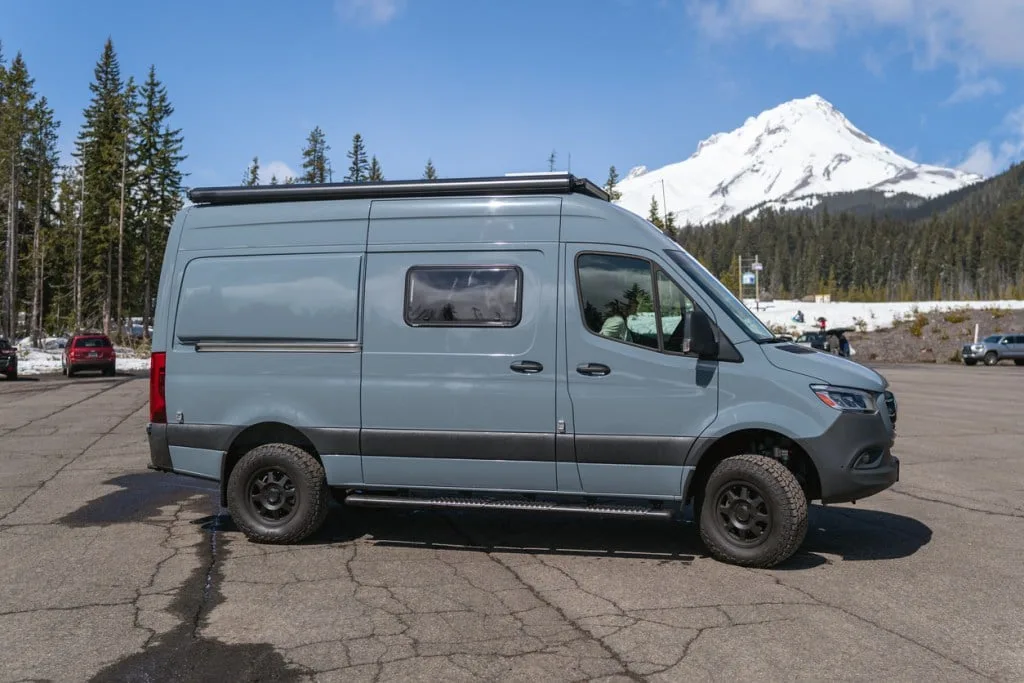
1. Not Checking the Weather Forecast Thoroughly
I know, I know—everyone says “always check the forecast.” But far too many folks do a quick peek at tomorrow’s weather and call it good. That’s not enough when you’re traveling in an RV during the winter. Snowstorms can roll in unexpectedly, and some regions experience weather shifts that make your head spin faster than a retro boombox cassette.
Why It’s a Mistake
- When you’re in an RV, you don’t have the same insulation or weather protection as a house.
- A freak snowstorm can make certain roads impassable or dangerous.
- Even a minor dip in temperature can freeze up your water lines if you’re not prepared.
How to Avoid It
- Use multiple sources: local news, weather apps, and radio updates. Cross-check them to see if they agree.
- Keep an eye on the weather for the week ahead, not just the next 24 hours.
- Plan a backup route if you see a storm heading your way.
Personal Tip
One winter, I thought I’d outsmart a storm by leaving a day early. Big mistake. Turned out, leaving early put me on the road in the worst part of the storm. If I had dug deeper into the forecast, I would’ve known it was better to wait two days until the skies cleared. Lesson learned: better safe than stranded.
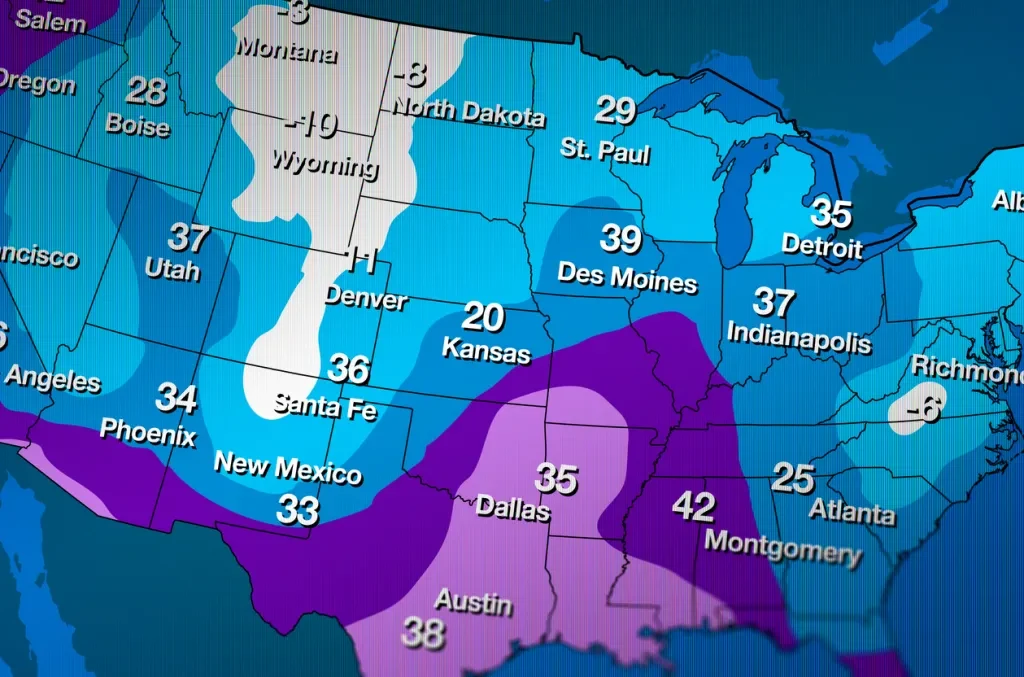
2. Neglecting Proper Insulation
RVers often assume their rig is ready for winter travel right off the lot. Truth is, most standard RVs are built for fairer weather. If you don’t take steps to add extra insulation, you could be in for a chilly surprise once those temperatures drop.
Why It’s a Mistake
- Poor insulation lets cold air slip inside, making your heating system work overtime.
- You’ll burn through propane or electric power faster.
- Frozen pipes can occur if your underbelly isn’t adequately protected.
How to Avoid It
- Skirting around your RV can help keep the undercarriage warmer.
- Insulated window coverings, like reflective bubble wrap, can cut down drafts.
- Check for gaps around doors, windows, and slide-outs—use weatherstripping or sealants to plug them.
Personal Tip
If you’re like me, you might have some old-school vinyl records stashed in a cupboard. Don’t use them to block drafts—invest in proper materials. Makeshift insulation might be tempting, but it rarely does the job well. A little money spent on real insulation can save you big on heating costs and potential repairs.
3. Forgetting to Winterize the Plumbing
Winterizing your plumbing isn’t just something your dad used to nag about—it’s a lifesaver when temperatures plummet. Whether you plan to use your water system or not, you need to protect it against freezing.
Why It’s a Mistake
- Freezing water expands, cracking pipes, valves, and even your fresh water tank.
- Repairs can be expensive and might require a visit to a specialized RV service center.
- Being stuck without usable water is no fun, especially in freezing temperatures.
How to Avoid It
- Drain your tanks and add RV antifreeze to your water lines if you plan on storing or not using them.
- If you’ll be using the system, invest in heated hoses and maintain a warm underbelly.
- Keep cabinet doors open to allow warm air to circulate around indoor pipes.
Personal Tip
When I first bought my RV, I assumed that my rig’s “all-season package” meant I could skip heavy-duty winterization. Spoiler: I couldn’t. A cracked pipe and a flooded bathroom later, I learned that “all-season” can be code for “slightly better, but not miracle-grade.” Always double-check your particular rig’s specs.
4. Overlooking Tire Care and Snow Chains
Driving in snowy conditions on bald or underinflated tires is a recipe for disaster. It’s like trying to do the Electric Slide on ice—you’re likely to crash and burn. Tires are literally the only contact your RV has with the road, so treat them right.
Why It’s a Mistake
- Underinflated tires lose traction more easily.
- Worn treads can’t grip snowy roads, leading to skids and slides.
- Ignoring snow chains or cables might leave you stranded in places where traction devices are required by law.
How to Avoid It
- Check tire pressure regularly, especially as temperatures fluctuate. Cold air can cause tire pressure to drop.
- Inspect your tire tread depth; if it’s worn down, replace the tires before heading into snowy conditions.
- Carry tire chains or cables if you plan on traveling in mountainous or high-snowfall areas. Practice installing them before you actually need them.
Personal Tip
I once got pulled over on a mountain pass because I didn’t have chains. Luckily, the state trooper let me buy some from a roadside stand and put them on before proceeding. Let’s just say it was the most expensive lesson in chain usage I’ve ever had.
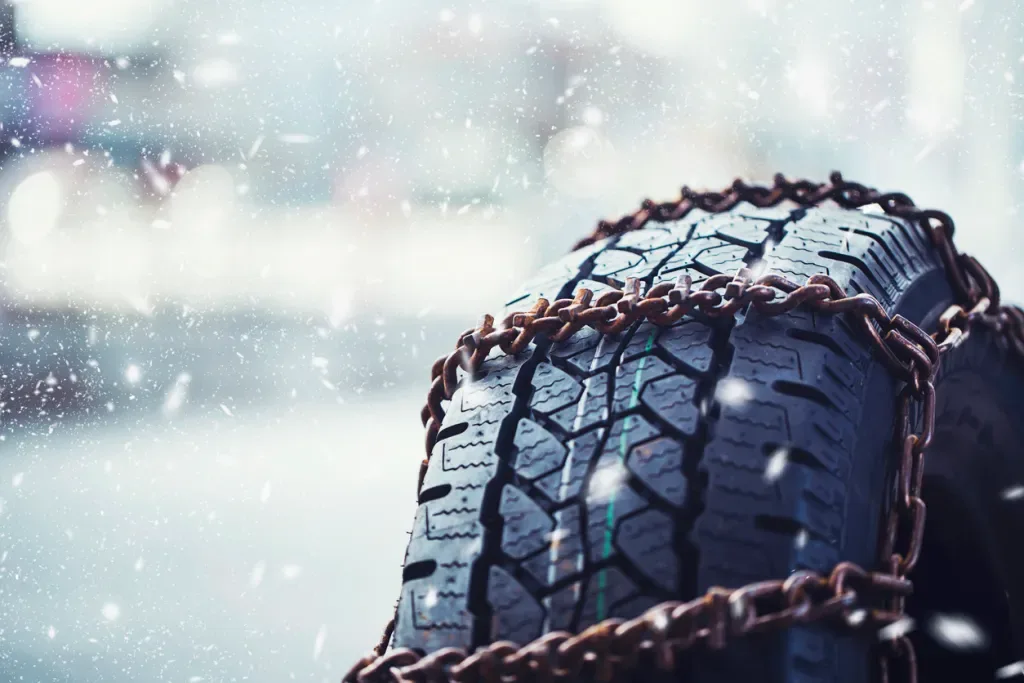
5. Not Protecting Your RV Battery
RV batteries are like the heart of your rig’s electrical system. If they go flat, you might be stuck without heat, lights, or a working fridge. And cold weather drains batteries faster than a Walkman from the ‘80s ate AA batteries.
Why It’s a Mistake
- Cold weather can reduce battery capacity by 20% or more.
- If your battery dies, you can’t run the furnace fan or ignition.
- Repeatedly letting batteries freeze or discharge completely can shorten their lifespan.
How to Avoid It
- Keep batteries charged to at least 50% when not in use.
- If you have a removable battery, store it somewhere warm when you’re not camping.
- Consider investing in a battery warmer or thermal blanket designed for RV batteries.
Personal Tip
My buddy once had his battery fail during a snowstorm. He ended up having to run his engine just to keep warm until morning. Now, we both carry portable jump-starters and keep our batteries well-insulated so we can avoid “freezing in the middle of nowhere” scenarios.
6. Ignoring Roof and Vent Maintenance
The roof is like the top of your fortress. In winter, snow collects there, and ice dams can form around vents. If you’re not paying attention, you could end up with leaks, or worse, damage to your roof’s structure.
Why It’s a Mistake
- Snow accumulation can become very heavy, stressing the roof.
- Ice can block your vents, causing poor airflow or even furnace malfunctions.
- Leaks in freezing temperatures can cause hidden damage that’s expensive to fix.
How to Avoid It
- Clear snow off your roof with a soft, extendable broom.
- Check and maintain the sealant around roof edges and vents regularly.
- Invest in vent covers that are designed for winter use; they let you keep vents open without letting snow and ice in.
Personal Tip
I remember a time in Colorado when a surprise overnight snowfall dropped over a foot of snow on my rig. I woke up to find water dripping onto my kitchen counter. Turns out, a blocked vent caused a backup that forced moisture inside. Now, I keep a telescopic roof rake on board—problem solved.
7. Relying Solely on Propane Heat
Propane furnaces are great, don’t get me wrong, but if you rely on them alone in a winter storm, you may run into problems. Propane might become scarce if everyone in the area is using it. Plus, propane furnaces can eat up your supply faster than expected.
Why It’s a Mistake
- If your propane tank empties in a remote spot, refills might be hard to find.
- When it’s extremely cold, the furnace can run almost nonstop.
- Propane lines can freeze if moisture is in the system.
How to Avoid It
- Bring along alternative heat sources like portable electric heaters (only if you have enough power or a reliable generator).
- Keep an eye on your propane levels using a gauge or by tapping the tank (the old-school method).
- Consider using space heaters or electric blankets to ease the load on your propane furnace.
Personal Tip
I once spent a winter night in a remote campground where the nearest propane refill was 25 miles away. My furnace drained the tank more quickly than I expected, leaving me shivering. After that, I started packing a small ceramic electric heater. Now I keep an extension cord and a proper campsite power setup, so I have a backup heat source without relying solely on propane.

8. Forgetting to Cover Exterior Hoses
Leaving hoses exposed in freezing temperatures is a surefire way to create an icy situation. You know that classic scene in “A Christmas Story” where the kid’s tongue gets stuck to a pole? Your hoses can suffer a similar fate if you’re not careful.
Why It’s a Mistake
- Water inside the hose can freeze solid, blocking any water flow.
- Hoses can crack when water expands.
- Frozen hoses can cause pressure buildup and damage RV fittings.
How to Avoid It
- Use heated hoses designed for RVs, or wrap your hoses in electrical heat tape.
- Keep hoses off the ground where possible, and use foam insulation sleeves if needed.
- Drain hoses when not in use, storing them in a warmer spot (like inside your rig) until you need them again.
Personal Tip
I used to think I could just let the faucets drip to keep water moving. That only works sometimes, and it’s also a waste of water. Now, I travel with a heated hose. It was one of the best investments I’ve made for winter camping. No more frozen hoses, and I can rest easy knowing I’ll have water in the morning.
9. Parking in the Wrong Spot
Location matters—especially when you’re dealing with snow. If you pick the wrong campsite or even the wrong angle within a site, you could set yourself up for a cold, windy, or sun-deprived stay.
Why It’s a Mistake
- Parking under trees with heavy snow can lead to branches breaking off and damaging your roof.
- If you park in a low area, melting snow can puddle around your RV, leading to icy conditions.
- Positioning your RV so the windshield faces the prevailing wind can cause extra wind chill.
How to Avoid It
- Look for a spot that’s relatively level and on higher ground.
- Avoid parking directly beneath dead or snow-laden branches.
- If possible, angle your RV so the biggest windows face the sun. It’ll help warm your rig naturally.
Personal Tip
I once parked in a scenic spot near a lake, only to find out later that it was a low-lying area. Two days of sunshine melted the snow, turning it into a mini swamp. My tires sank into the mud, and I had to get a tow truck to pull me out. Now, I always walk the site first, even if it’s freezing out.
10. Skipping On-Site Prep and Leveling
Some folks think leveling is just for comfort. But in snowy conditions, proper leveling can be the difference between a cozy stay and a lopsided fiasco. If your RV isn’t level, you risk issues ranging from water not draining to appliances malfunctioning.
Why It’s a Mistake
- Refrigerators in RVs need relatively level conditions to operate correctly.
- Water in plumbing systems may not drain properly, increasing the chance of freezing in low spots.
- Stability is crucial when you have ice or slippery conditions outside.
How to Avoid It
- Use leveling blocks or a hydraulic leveling system to get your RV as flat as possible.
- Double-check your bubble levels on both the side-to-side and front-to-back axes.
- If the ground is frozen and your blocks slip, consider rubber mats underneath for extra grip.
Personal Tip
I once camped in the mountains where the only available spot was on a slight incline. I thought, “No biggie,” and set up shop. By morning, my fridge had started acting up and my coffee pot leaked water all over the countertop because the rig was so tilted. Lesson learned: level is not optional, even if it takes a few extra minutes in the cold.
11. Underestimating Fuel Needs
Whether you rely on gas for your generator or diesel for your engine, don’t assume you can just roll into the next station anytime you want—especially during a snowstorm. Rural areas might have limited hours or closures during extreme weather.
Why It’s a Mistake
- Running out of fuel in cold weather leaves you without a heat source if you rely on a generator.
- If you can’t start your vehicle, you’re stuck—and possibly in danger if the weather turns nasty.
- Snowstorms can knock out power at gas stations, making pumps unusable.
How to Avoid It
- Always top off your fuel before heading into an area expecting snow.
- Keep extra fuel in approved containers if it’s safe and legal to do so in your location.
- Plan your route so you pass through areas with reliable fuel stops.
Personal Tip
During a road trip to northern Idaho, I rolled the dice and waited for a “cheaper gas station” further down the highway. Of course, the storm shut that station down early. I limped on fumes to the next town, absolutely stressed out. Now, whenever I see a station in winter, I top off. Peace of mind is worth a few extra bucks.
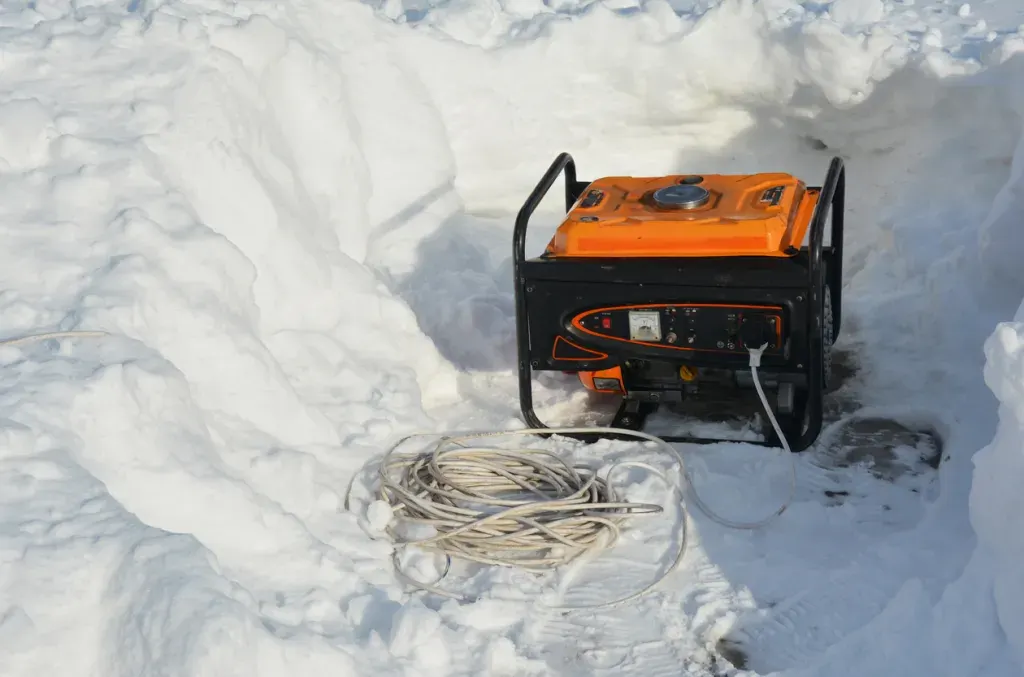
12. Overloading the RV
When packing for winter, it’s easy to go overboard—extra blankets, heavier clothes, maybe a generator. But watch your weight. An overloaded RV isn’t just bad for your MPG; it can be downright dangerous on slippery roads.
Why It’s a Mistake
- Excess weight affects braking distance, especially on snow or ice.
- It can cause uneven tire wear, leading to traction issues.
- Overloading may stress your suspension, leading to costly repairs or even structural damage.
How to Avoid It
- Weigh your rig at a truck scale after loading up. Make sure you’re within your GVWR (Gross Vehicle Weight Rating).
- Store heavier items low to the ground for better stability.
- If you’re carrying things you rarely use, consider leaving them behind or upgrading to lighter gear.
Personal Tip
I once hoarded so much firewood, it felt like I was opening a lumber yard in my RV. The drive was nerve-racking because every bump felt amplified, and braking took way longer. After that trip, I learned about load balancing and only bring what I really need.
13. Not Having a Backup Heat Source or Plan
In winter, backup plans are your best friend. If your furnace fails, if you run out of propane, or if your generator dies, you’ll want another way to stay warm—especially if you’re boondocking far from a main road.
Why It’s a Mistake
- Hypothermia is a real danger if you lose heat in a severe storm.
- Some campgrounds lose power, leaving you without an electric heater option.
- Even minor issues can become major if you’re not prepared (like a fuse blowing in the middle of the night).
How to Avoid It
- Keep an electric blanket or battery-powered heater on hand, if possible.
- Learn safe ways to use a catalytic heater or wood stove, if your RV is equipped.
- Store extra warm bedding and clothing in a dry spot.
Personal Tip
I used to rely on the furnace alone, until one night the furnace igniter decided to quit at 2 a.m. Let me tell you, that was one cold and uncomfortable evening. Now, I keep a small but effective portable heater. I also have an emergency bag with extra blankets, just in case.
14. Failing to Stock Enough Food and Water
If you’re stuck in a snowstorm, the last thing you want is to run out of food or clean water. We’re not talking about hoarding like it’s Y2K, but you should have enough supplies to last a few days longer than you plan to stay.
Why It’s a Mistake
- Winter storms can block roads, preventing you from restocking.
- Some campgrounds or rural stores may close if the weather’s bad.
- Dehydration is still a risk in cold weather, and you’ll also use water for cooking, cleaning, and toilet flushing.
How to Avoid It
- Keep a few extra gallons of drinking water in safe, non-freezing storage.
- Stock canned goods, pasta, rice, and other foods that last a while and are easy to cook.
- Don’t forget emergency snacks. Sometimes a little sugar can boost morale if you’re stuck.
Personal Tip
I once spent a week “trapped” at a small campground during a freak blizzard. The closest store was 15 miles away, and it was closed. Thankfully, I had a pantry full of soup, beans, rice, and spices. I turned it into a cozy cooking adventure instead of a panic-fest.
15. Leaving the Awning Out
When it’s snowing, you might think the awning provides extra shelter. But snow buildup on an awning can get heavy fast. If you leave it extended, you risk damage to the awning arms, fabric, or even your RV’s side wall.
Why It’s a Mistake
- Snow and ice can weigh down the awning, causing it to bend or collapse.
- A sudden gust of wind can wreak havoc on a partially frozen awning.
- Repairing an awning can be expensive, and it’s not fun dealing with that in freezing temps.
How to Avoid It
- Retract your awning whenever you expect snowfall or ice storms.
- If you must keep it out, clear snow frequently with a broom or squeegee.
- Consider a sturdy awning support system, but remember, no awning is invincible against Mother Nature.
Personal Tip
I used to love the idea of a covered patio area in winter, until I realized how quickly the snow piled up. One night, I heard a snap and found the awning arms bent under a mound of snow. That repair wasn’t cheap. Now, I keep the awning in any time I see a hint of snowfall in the forecast.
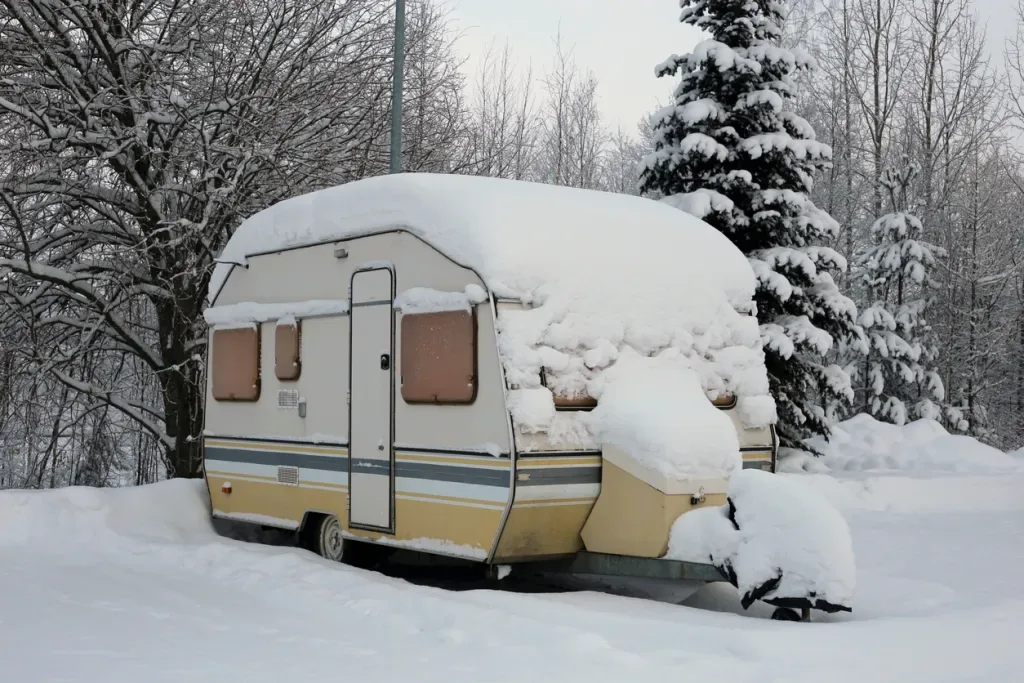
16. Forgetting to Maintain Proper Ventilation
When it’s cold out, the instinct is to seal up every crack. But without proper ventilation, you risk moisture buildup inside your RV, which can lead to condensation, mold, and even health issues.
Why It’s a Mistake
- Cooking, heating, and even breathing can add moisture to the air.
- In an enclosed space, moisture settles on cold surfaces like windows and walls.
- Over time, mold or mildew can grow, turning your cozy RV into an unhealthy environment.
How to Avoid It
- Crack a window or use a roof vent with a cover to keep air flowing.
- Use a dehumidifier or moisture-absorbing products (like DampRid) if humidity is high.
- Wipe down windows and surfaces where condensation appears.
Personal Tip
I remember one winter morning waking up to a light layer of frost on the inside of my RV windows. That’s how high the moisture level was! Now, no matter how cold it gets, I leave a vent cracked open and run a small dehumidifier. The air is fresher, and I don’t have to worry about mold creeping in.
17. Not Having an Emergency Kit or Exit Plan
Last but not least, many RVers don’t prepare for emergencies because they think, “It won’t happen to me.” But winter can be unpredictable. From sudden blizzards to mechanical breakdowns, you need a plan for those “what ifs.”
Why It’s a Mistake
- A flat tire in the middle of nowhere can quickly turn dangerous if help can’t reach you due to snow.
- Road closures can trap you longer than expected.
- Medical issues can become more serious if you’re isolated.
How to Avoid It
- Keep a well-stocked emergency kit: first aid supplies, flashlight, batteries, blankets, and basic tools.
- Carry a shovel, ice scraper, and traction mats for getting out of snowy spots.
- Know your exit routes. If the main highway closes, do you have an alternative way out?
Personal Tip
I travel with a small “go bag” that has a first aid kit, extra gloves, socks, snacks, and a phone charger. I also keep a shovel and a bag of sand to help with tire traction. It might sound like overkill until you’re stuck on a frosty back road at dusk, praying another car comes by.
Enjoy the Snow, Don’t Fear It
Winter RVing isn’t for the faint of heart, but it can be one of the most rewarding ways to travel. There’s nothing quite like looking out your RV window at a fresh blanket of snow, knowing you’re warm and well-prepared inside. Yeah, it can be a bit more complicated than a summer road trip, but if you avoid these 17 common mistakes, you’ll be way ahead of the game.
From double-checking the weather forecast to stocking up on fuel, insulation, and backup supplies, each of these steps is like putting together a puzzle that’ll form the perfect winter camping picture. Think of it like the build-up to a great Gen X mixtape: each track (or tip) needs to be in place to create the ultimate vibe.
And remember, if things do go wrong—and sometimes they will—don’t beat yourself up. Chalk it up as part of the adventure. Us Gen Xers grew up learning to solve problems on the fly. Whether it’s a broken Walkman or a frozen water line, we adapt, we innovate, and we get the job done. That’s part of the fun, right?
So go ahead, embrace the cold, and let the snow bring out the kid in you who once made snow angels in the front yard. Just do it the smart way, with a little planning and a healthy respect for Mother Nature’s winter mood swings. Stay safe, stay warm, and most importantly, enjoy the ride. Your winter RV adventure is waiting—just make sure you’re prepared to take it on like a true road warrior. Safe travels and happy camping!
We’ll Help You Find the Best Free Camping in the USA
You should give it a try!
As a matter of fact, these free campsites are yours to enjoy. Every time you pay federal taxes, you’re contributing to these lands.
Become a FREE CAMPING INSIDER and join the 100,000 campers who love to score the best site!
We’ll send you the 50 Best Free Campsites in the USA (one per state). Access the list by submitting your email below: